Appliances
Why Ceiling Fan Slow

Ever pondered over the reason your ceiling fan appears to function at a speed that’s not quite up to par? In our exploration to grasp the intricacies of this frequent event, we have pinpointed a number of elements that play a role in the slowness of ceiling fans.
From incorrect fan settings to faulty motor performance, there are numerous reasons that can impede the optimal functioning of these household fixtures.
In addition, dust accumulation on the fan blades, improper installation, and low fan speed settings can all play a role in the reduced speed of your ceiling fan.
Furthermore, remote control malfunctions, fan capacitor failures, incorrect fan directions, and faulty switches can also contribute to this issue.
Join us as we delve into the various causes behind a slow ceiling fan and explore potential solutions to restore its efficiency.
Key Takeaways
- Incorrect fan speed control switch settings
- Obstruction of airflow due to dust or debris on the blades
- Fan motor issues causing a decrease in fan speed and performance
- Regular cleaning of fan blades to prevent dust accumulation and maintain optimal airflow
Incorrect Fan Settings
When troubleshooting ceiling fan speed issues, one common culprit to consider is incorrect fan settings. Fan speed control plays a crucial role in determining the airflow and comfort level in a room. If the settings aren't properly adjusted, it can result in a slow or ineffective fan speed.
To begin, check the fan speed control switch located on the fan itself or on the wall. Ensure that it's set to the desired speed, such as high, medium, or low. Sometimes, due to accidental contact or improper handling, the switch may get shifted to a lower speed setting, causing the fan to operate at a slower speed.
Another factor to consider is airflow obstruction. If the fan blades are obstructed by dust or debris, it can reduce the airflow and result in a slower fan speed. Regularly clean the blades using a soft cloth or brush to remove any build-up. Additionally, make sure that there are no obstacles such as furniture or curtains blocking the airflow.
Faulty Fan Motor
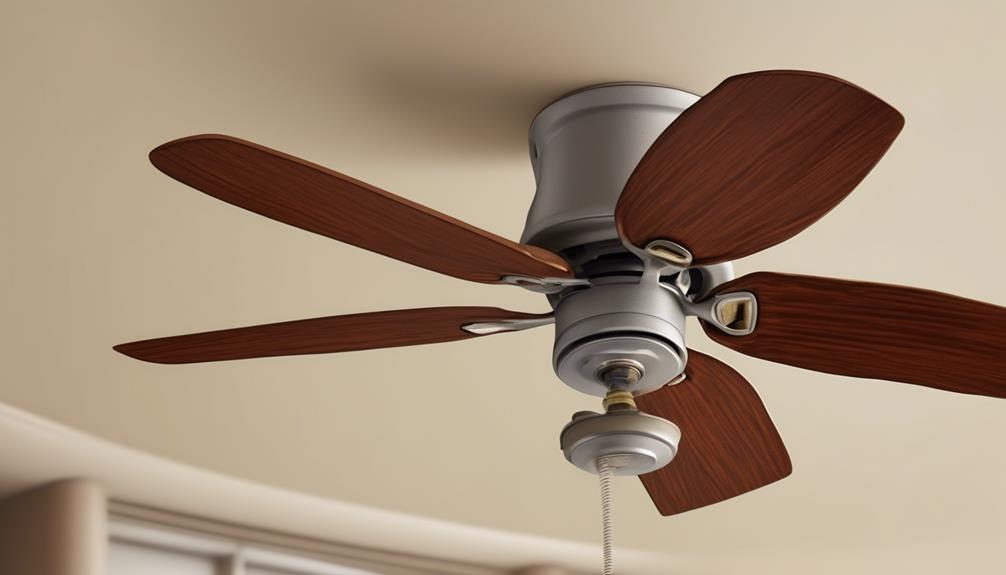
The fan motor may become faulty, resulting in a decrease in fan speed and performance. When the motor malfunctions, it can cause the fan to operate at a slower speed than usual or produce irregular movements. Additionally, a faulty fan motor may generate excessive fan noise, which can be disruptive and bothersome. To address this issue, it's essential to consider motor replacement as a potential solution.
If you notice that your ceiling fan is running slower than normal or experiencing irregular movements, it's likely due to a faulty motor. These motors are responsible for driving the fan blades and ensuring their smooth rotation. Over time, wear and tear can cause the motor's internal components to degrade, resulting in reduced performance.
In some cases, a faulty motor may also generate excessive fan noise. This can occur due to worn-out bearings or misalignment within the motor. The noise can be a sign of impending motor failure and shouldn't be ignored.
To rectify the issue, motor replacement is often the recommended course of action. By replacing the faulty motor with a new one, you can restore your ceiling fan's functionality and eliminate any fan noise or decreased performance. It's advisable to consult a professional technician or contact the manufacturer for assistance in selecting and installing the appropriate replacement motor.
Dust Accumulation on Fan Blades
We have identified three key points regarding the issue of dust accumulation on fan blades.
Firstly, dust build-up can cause the rotation of the fan blades to slow down significantly, resulting in reduced fan speed.
Secondly, cleaning the fan blades regularly can effectively improve the speed and performance of the ceiling fan.
Lastly, regular maintenance, including dusting the fan blades, can help prevent sluggishness and ensure optimal fan operation.
Dust Build-Up Causes Slow Rotation
Excessive dust accumulation on the fan blades can lead to a decrease in rotation speed. When dust builds up on the blades, it can disrupt the balance and weight distribution, causing the fan to rotate at a slower speed.
Additionally, the dust acts as a barrier, restricting the airflow and reducing the efficiency of the fan. This decrease in rotation speed not only affects the overall performance of the fan but also hampers its ability to provide adequate airflow in the room.
Regular cleaning of the fan blades is essential to prevent dust accumulation and maintain optimal fan speed control. By removing the dust build-up, you can ensure unrestricted airflow and maximize the rotation speed of your ceiling fan.
Cleaning Improves Fan Speed
To optimize the rotation speed of your ceiling fan and prevent dust accumulation, regular cleaning of the fan blades is crucial. Dust build-up on the fan blades can lead to decreased airflow, resulting in slower fan speed and reduced efficiency. Cleaning the fan blades not only improves the aesthetic appearance of the fan but also ensures proper functioning.
Regular cleaning of the fan blades offers several benefits. Firstly, it helps maintain optimal fan speed regulation by preventing dust from weighing down the blades and impeding their movement. Secondly, it enhances the airflow in the room, promoting better ventilation and a more comfortable environment. Lastly, by removing dust, cleaning reduces the strain on the motor, extending its lifespan and reducing the likelihood of malfunctions.
When cleaning the fan blades, it's important to use a soft cloth or a duster to gently wipe away the dust. Avoid using abrasive materials or harsh chemicals that could damage the blades or the motor. Regular cleaning, when done correctly, improves fan speed and ensures the longevity and effectiveness of your ceiling fan.
Maintenance Prevents Sluggishness
Regular maintenance is essential to prevent sluggishness caused by dust accumulation on the fan blades.
Dust particles can build up on the blades over time, reducing the fan's efficiency and airflow.
To avoid this issue, it's important to perform regular cleaning and maintenance.
Cleaning the fan blades should be done at least once every three months, or more frequently if the fan is used in a dusty environment.
Start by turning off the fan and using a soft cloth or brush to gently wipe away the dust.
For more stubborn dirt, a mild detergent solution can be used.
After cleaning, ensure that the blades are completely dry before turning on the fan again.
Improper Installation
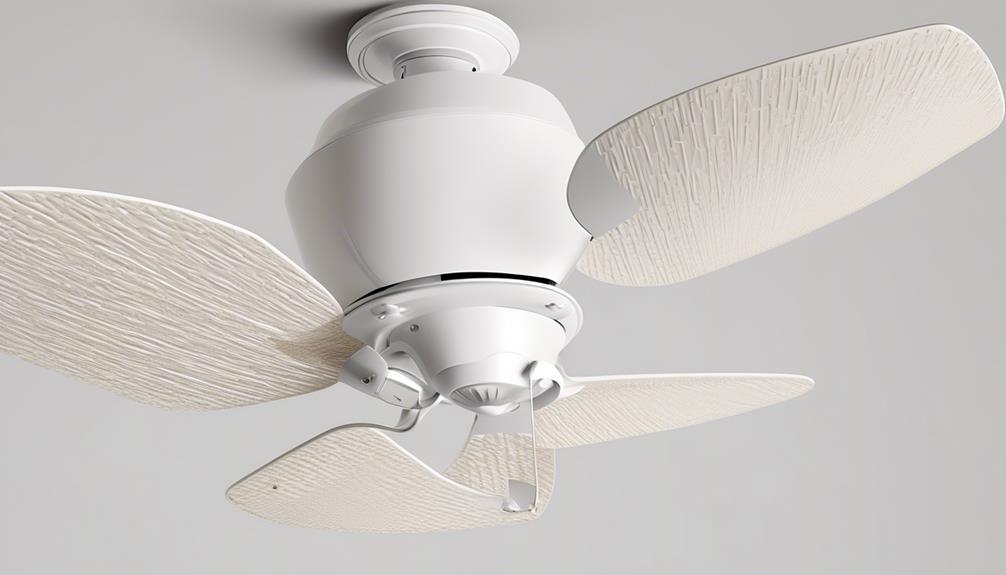
Improperly installed ceiling fans can lead to a range of speed issues, affecting their overall performance and efficiency. When it comes to fan installation, following the proper guidelines is crucial. Here are some fan installation tips to help troubleshoot fan performance:
- Ensure that the fan is securely mounted: A loose or wobbly fan can cause it to operate at a slower speed than intended.
- Use the correct downrod length: Incorrectly sized downrods can hinder the fan's ability to circulate air effectively, resulting in reduced speed.
- Double-check the wiring connections: Loose or incorrect wiring can cause the fan to operate at a slower speed or not work at all.
- Verify the installation of the blades: If the blades aren't correctly aligned or installed, it can create an imbalance that affects the fan's speed.
- Check for any obstructions: Make sure that there are no objects or debris obstructing the fan's movement, as this can hinder its performance.
Proper fan installation is vital in ensuring optimal performance. By following these fan installation tips, you can troubleshoot speed issues and ensure that your ceiling fan operates efficiently, providing you with the desired comfort and airflow.
Low Fan Speed Setting

When addressing low fan speed settings, it's important to understand how this particular issue can impact the overall performance and airflow of a ceiling fan. Fan speed controls play a crucial role in regulating the rotation speed of the blades, which directly affects the amount of air that's circulated in the room. If a ceiling fan is running at a low speed despite being set at a higher speed, troubleshooting slow fan speed becomes necessary to identify and resolve the underlying problem.
One common cause of low fan speed is a faulty or worn-out fan motor. The motor is responsible for driving the rotation of the blades, and if it isn't functioning properly, it can result in reduced speed. In this case, replacing the motor might be necessary to restore the fan's performance.
Another potential cause is an issue with the fan speed control mechanism. This can include problems with the fan's switch, capacitor, or regulator. Inspecting and repairing or replacing these components can often resolve the slow speed issue.
Additionally, it's worth noting that the size and design of the ceiling fan can also impact its speed. Fans with larger blades or a more aerodynamic design tend to generate more airflow even at lower speed settings.
Loose Fan Blades
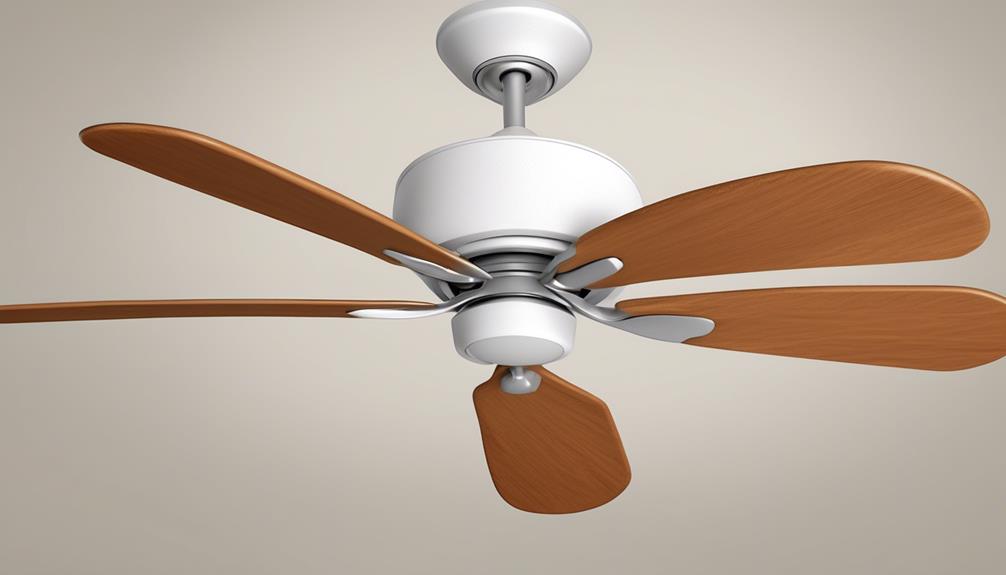
We need to address the issue of loose fan blades, which can cause a decrease in the fan's performance and create unnecessary noise.
There are two main points to consider when discussing this problem: blade alignment issues and loose blade screws.
Blade alignment issues occur when the blades aren't positioned correctly, leading to imbalanced rotation and reduced airflow.
Loose blade screws can also contribute to the problem by allowing the blades to wobble, affecting the fan's efficiency.
Blade Alignment Issues
Loose fan blades can lead to an imbalance in the ceiling fan's rotation, resulting in potential speed issues. When the blades aren't properly aligned, it can cause the fan to wobble or shake, affecting its performance.
Here are some key factors to consider when dealing with blade alignment issues:
- Blade balance: Ensuring that each blade is evenly weighted is crucial for the smooth operation of the fan. Imbalanced blades can disrupt the airflow and lead to speed fluctuations.
- Motor speed: The motor speed should be consistent and stable to maintain a steady rotation. Misaligned blades can put strain on the motor, causing it to slow down or even fail.
- Blade angle: Correctly positioning the blades at the appropriate angle is essential for optimal airflow. Improper alignment can hinder the fan's ability to circulate air effectively.
- Tightening screws: Regularly checking and tightening the screws that secure the blades to the fan's motor housing can prevent blade misalignment.
- Regular maintenance: Conducting routine inspections and maintenance, including cleaning the blades and checking for any signs of wear or damage, can help identify and address alignment issues promptly.
Loose Blade Screws
To address the issue of blade misalignment, it is crucial to examine the tightness of the screws securing the fan blades to the motor housing. Loose blade screws can cause the fan blades to wobble, resulting in reduced air circulation and an inefficient fan performance. Regular blade maintenance is essential to ensure the optimal functioning of your ceiling fan. One of the key aspects of blade maintenance is checking the tightness of the blade screws. By tightening any loose screws, you can restore proper alignment and enhance the overall performance of your fan. To effectively control the fan speed, it is important to ensure that all the blade screws are securely tightened. Refer to the table below for a quick guide on blade maintenance and fan speed control.
| Blade Maintenance | Fan Speed Control |
|---|---|
| Check screw tightness regularly | Adjust fan speed settings |
| Tighten loose screws | Use a fan speed controller |
| Ensure proper blade alignment | Clean fan blades regularly |
| Use lock washers for added security | Avoid obstructing the fan with furniture or objects |
| Replace damaged screws or washers | Balance fan blades if necessary |
Worn-Out Fan Bearings

The worn-out fan bearings can significantly affect the speed of the ceiling fan. Fan bearings are crucial components that enable smooth rotation of the fan blades. Over time, these bearings can wear out due to continuous usage. When the bearings are worn-out, there are several issues that can arise, impacting the fan's performance:
- Increased fan noise: Worn-out bearings can produce an annoying humming or grinding noise, indicating the need for replacement.
- Reduced fan speed: As the bearings deteriorate, the fan's rotation may become sluggish, resulting in a decrease in speed.
- Increased friction: The friction generated by worn-out bearings can put strain on the motor, leading to reduced efficiency and increased energy consumption.
- Limited lubrication: Lubrication is essential to reduce friction and ensure smooth operation. However, worn-out bearings may prevent effective lubrication, further exacerbating the problem.
- Risk of overheating: When the bearings are in poor condition, the fan's motor may overheat due to increased friction, potentially causing damage or even fire hazards.
To address worn-out fan bearings, it's necessary to replace them with new ones. Regular maintenance, including lubricating bearings, can help extend their lifespan. By keeping the fan bearings in good condition, you can ensure optimal performance and prolong the life of your ceiling fan.
Inadequate Power Supply

We will now address the issue of inadequate power supply, which can cause speed issues in ceiling fans.
There are a few possible reasons for this problem.
First, voltage fluctuations in the electrical system can affect the fan's speed.
Second, loose electrical connections can disrupt the flow of power and result in inconsistent performance.
Lastly, a malfunctioning motor can also contribute to speed issues.
Voltage Fluctuations
Voltage fluctuations can cause issues with the speed of a ceiling fan when there's an inadequate power supply. These fluctuations, often caused by voltage regulation problems or electrical surges, can disrupt the smooth operation of the fan's motor, resulting in reduced speed or even complete malfunction. It's important to understand the impact of voltage fluctuations on the performance of a ceiling fan to ensure proper operation and longevity.
- Erratic speed variations: Voltage fluctuations can cause the ceiling fan to spin at inconsistent speeds, leading to an uncomfortable indoor environment.
- Motor overheating: Fluctuations in voltage can result in increased current flow, causing the motor to overheat and potentially leading to motor failure.
- Uneven airflow: Inadequate power supply can cause the fan blades to rotate at different speeds, resulting in uneven air circulation throughout the room.
- Noise and vibration: Voltage fluctuations can lead to increased noise and vibration levels, causing annoyance and discomfort to occupants.
- Reduced lifespan: Continuous exposure to voltage fluctuations can shorten the lifespan of the ceiling fan, requiring frequent replacements and repairs.
To avoid these issues, it's crucial to ensure a stable and regulated power supply to the ceiling fan, utilizing appropriate voltage regulation mechanisms and surge protection devices.
Loose Electrical Connections
Loose electrical connections can significantly impact the performance and reliability of a ceiling fan. Particularly when it comes to inadequate power supply. When the wiring connections in a ceiling fan become loose, it can result in a weak electrical connection, leading to various electrical issues.
Loose wiring can cause the fan to function at a lower speed or not work at all. The fan may also experience intermittent power interruptions, causing it to stop and start unexpectedly. These loose connections can cause overheating, which can lead to damage to the fan's motor or other components.
It's crucial to regularly check and tighten all electrical connections in a ceiling fan to ensure optimal performance and prevent potential hazards.
Motor Malfunction
Motor malfunction due to inadequate power supply can cause significant issues with the performance and reliability of a ceiling fan. When the motor doesn't receive enough power, it may not be able to operate at its full capacity, resulting in reduced speed and airflow. Troubleshooting techniques for motor repair involve identifying and rectifying the inadequate power supply.
Here are five common issues related to motor malfunction caused by inadequate power supply:
- Insufficient voltage from the power source.
- Loose or faulty wiring connections.
- Overloaded circuit causing voltage fluctuations.
- Inadequate amperage in the electrical circuit.
- Power surges or fluctuations from the utility provider.
To ensure optimal performance, it's crucial to address motor malfunctions promptly. Proper troubleshooting techniques, such as checking the power supply and addressing any issues, can help resolve motor malfunctions and restore your ceiling fan's functionality.
Dirty or Clogged Air Vents
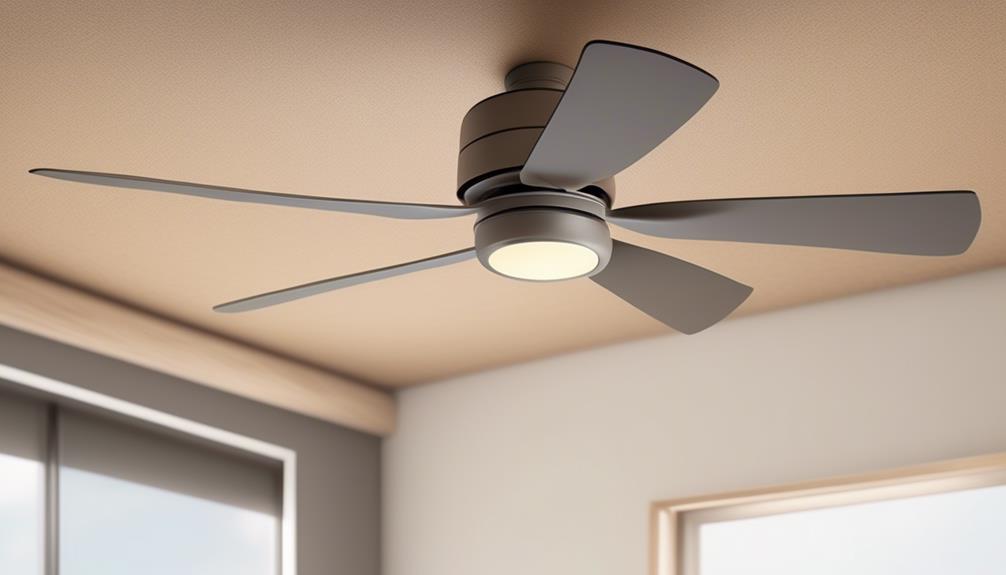
Air vents in a ceiling fan can become dirty or clogged, leading to diminished airflow and reduced cooling effectiveness. One common culprit is a dirty air filter. Over time, dust and debris can accumulate on the air filter, obstructing the flow of air. This restricts the amount of air that can pass through the fan and circulate in the room.
To resolve this issue, the air filter should be cleaned regularly or replaced if necessary. Another potential cause of clogged air vents are blocked air ducts. If the air ducts leading to the ceiling fan are obstructed by dust, dirt, or other debris, it can disrupt the airflow and reduce the fan's performance.
To address this problem, the air ducts should be inspected and cleaned if needed. Regular maintenance and cleaning of both the air filter and air ducts can help ensure optimal airflow and cooling efficiency.
Obstructions Near the Fan
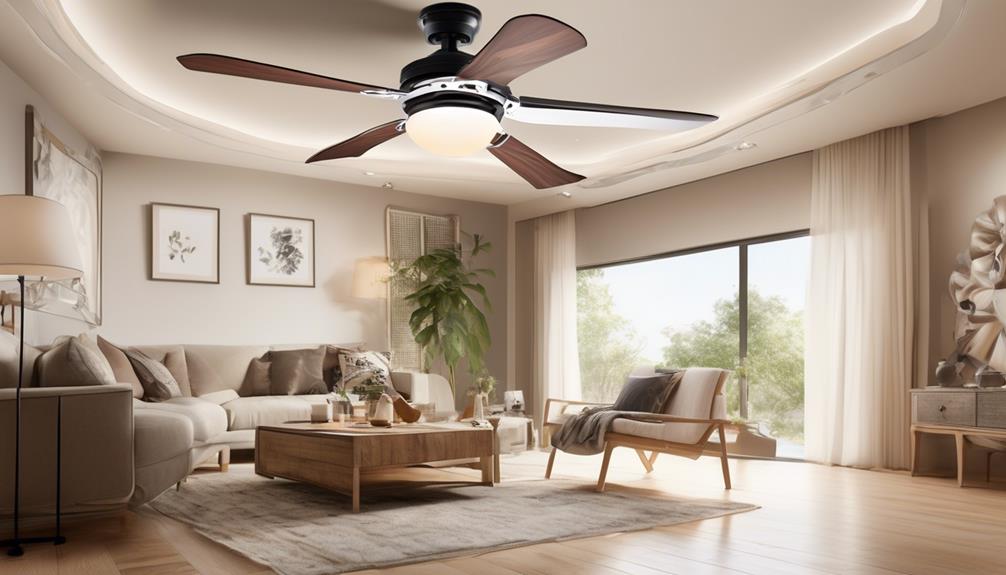
We need to consider the presence of obstructions near the fan as a potential cause of speed issues.
Firstly, furniture blocking the airflow can disrupt the smooth circulation of air and result in reduced fan speed.
Additionally, dust accumulation on the blades can create an imbalance, causing the fan to operate at a lower speed.
Lastly, it's important to check that the fan speed setting isn't inadvertently set to a lower level, as this can also contribute to slower fan speeds.
Furniture Blocking Airflow
One common issue that can affect the speed of a ceiling fan is the presence of obstructions, such as furniture, near the fan. When furniture is placed too close to the fan, it can disrupt the airflow and hinder the fan's ability to circulate air effectively.
Here are five reasons why furniture blocking airflow can be a problem:
- Furniture restricts the movement of air, reducing the fan's ability to cool the room efficiently.
- The presence of furniture near the fan can create turbulence, causing the air to swirl unevenly and reducing the overall airflow.
- Furniture can create a barrier that prevents air from reaching certain areas of the room, resulting in uneven cooling or heating.
- When furniture blocks the path of the fan blades, it can put additional strain on the motor, leading to decreased fan performance and potential damage over time.
- Furniture can also create noise and vibrations when it obstructs the airflow, causing discomfort and distraction.
To optimize the performance of your ceiling fan, ensure that there's sufficient clearance around it and that no furniture obstructs its airflow.
Dust Accumulation on Blades
Dust accumulation on the blades of a ceiling fan can significantly impact its performance and airflow efficiency. Over time, dust particles settle on the blades, causing an imbalance and reducing the fan's ability to circulate air effectively. To maintain optimal performance, regular blade cleaning is essential.
Here are some maintenance tips to ensure your ceiling fan operates at its best.
First, turn off the fan and wait for the blades to stop moving completely.
Next, using a soft cloth or a vacuum cleaner with a brush attachment, gently wipe or vacuum the dust off the blades. Be thorough in removing all the dust particles.
Finally, ensure the blades are completely dry before turning the fan back on.
Low Fan Speed Setting
Obstructions near the fan can cause a decrease in its speed setting. When objects are placed too close to the fan, they disrupt the airflow and create resistance, resulting in a lower speed setting. This issue is particularly common in energy efficient fan models, as they're designed to operate at lower speeds to save energy. However, it's important to note that the impact of fan speed on energy consumption is minimal.
Here are five common obstructions that can affect the speed setting of a ceiling fan:
- Furniture positioned directly beneath the fan
- Curtains or drapes hanging too close to the blades
- Decorative objects or plants placed on top of the fan
- Low ceilings that limit the vertical movement of the blades
- Excessive dust or dirt buildup on the blades, which can create imbalance and drag
To ensure optimal performance, it's essential to keep the area around the fan clear of any obstructions. Regular cleaning and maintenance can also help in maintaining the fan's speed and efficiency.
Fan Blade Pitch Adjustment
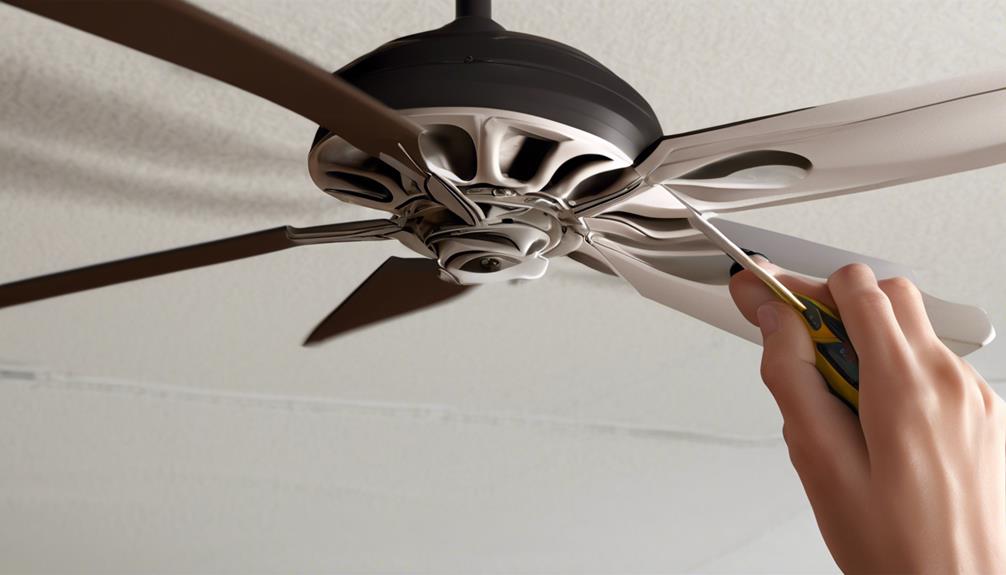
To ensure optimal fan performance, adjusting the pitch of the fan blades is a crucial step. Fan blade pitch refers to the angle at which the blades are set in relation to the fan's motor. By adjusting the pitch, you can effectively control the airflow produced by the fan and enhance its overall function.
When it comes to fan blade pitch adjustment, it is important to understand the impact it has on the fan's performance. A steeper pitch will generate more airflow, while a shallower pitch will create less airflow. Therefore, if you want to increase the fan's speed, you can adjust the pitch to a steeper angle. On the other hand, if you prefer a slower fan speed, you can adjust the pitch to a shallower angle.
To give you a better understanding of how adjusting the fan blade pitch affects the fan speed, take a look at the table below:
| Blade Pitch | Fan Speed |
|---|---|
| Steep | High |
| Moderate | Medium |
| Shallow | Low |
As you can see, changing the fan blade pitch directly affects the speed at which the fan operates. So, if you're experiencing low fan speed, considering adjusting the blade pitch may help improve its performance.
Remote Control Malfunction
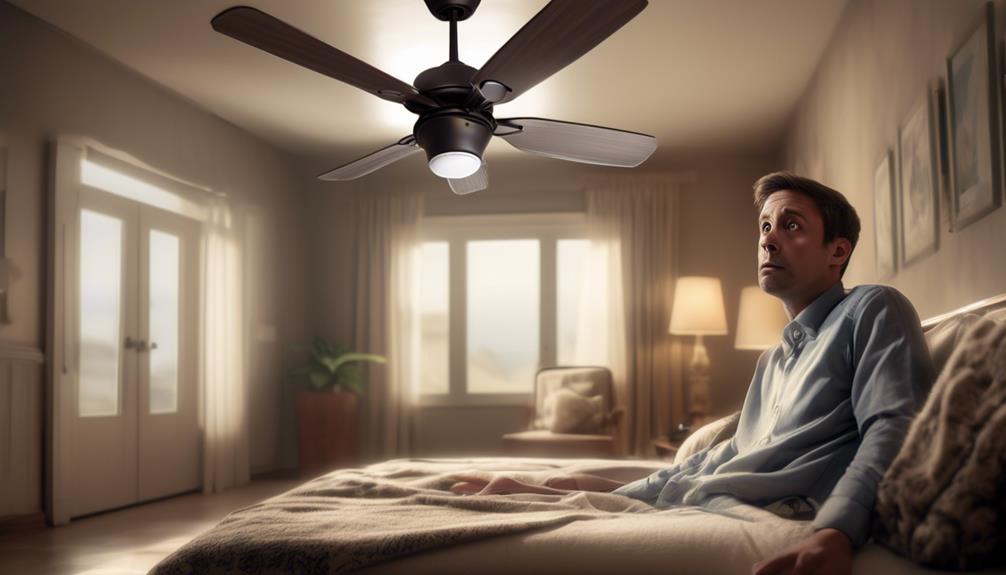
Our first step in addressing the issue of remote control malfunction is to check the batteries. Often, the problem lies simply in the batteries being low or dead.
If that doesn't solve the issue, here are some remote control troubleshooting tips to consider:
- Make sure the remote control is within range of the ceiling fan. If it's too far away, the signal may not be reaching the fan properly.
- Check for any obstructions between the remote control and the fan, such as furniture or walls. These can interfere with the signal.
- Try resetting the remote control by removing the batteries, pressing all the buttons to discharge any residual power, and then putting the batteries back in.
- If the remote control still doesn't work, it may be time to consider a remote control replacement. Look for a compatible remote control that matches your ceiling fan model.
- Consider consulting the instruction manual for your ceiling fan to see if there are any specific troubleshooting steps or remote control programming instructions.
Fan Capacitor Failure
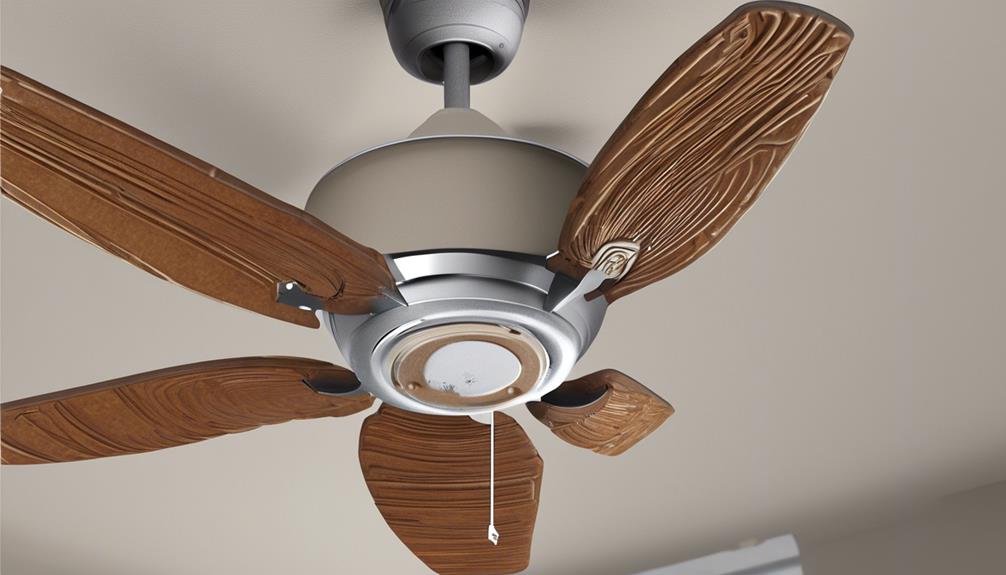
Fan capacitors can sometimes fail, leading to issues with the speed and performance of the ceiling fan. When a fan capacitor fails, it can result in the fan running at a slower speed than usual or not running at all. This can be frustrating for homeowners who rely on their ceiling fans for cooling and air circulation.
To troubleshoot a fan capacitor issue, the first step is to check for any visible signs of damage, such as bulging or leaking. If the capacitor appears damaged, it's likely in need of replacement. However, sometimes a capacitor may fail without any visible signs, so further testing is required.
To test the fan capacitor, a multimeter can be used to measure its capacitance. The capacitance reading should match the value specified by the manufacturer. If the reading is significantly lower or higher, it indicates a faulty capacitor that needs to be replaced.
When replacing a fan capacitor, it's important to ensure that the new capacitor has the same capacitance rating as the original. Capacitors come in different sizes and voltage ratings, so it's crucial to select the correct replacement.
Incorrect Fan Direction

The direction in which a ceiling fan rotates can be incorrectly set, causing issues with its performance. When a ceiling fan is spinning in the wrong direction, it can lead to reduced airflow and inefficient cooling or heating. Here are five reasons why incorrect fan direction can affect the fan speed and overall performance:
- Reverse airflow: When the fan is set to rotate in reverse, it creates an updraft that pushes warm air downwards. This can be beneficial during colder months but can hinder cooling efficiency during the summer.
- Circulation disruption: Incorrect fan direction can disrupt the natural circulation of air in a room, leading to stagnant pockets of hot or cold air.
- Increased energy consumption: If the fan is spinning in the wrong direction, it can create additional resistance, causing the motor to work harder and consume more energy.
- Reduced air movement: A fan spinning in the incorrect direction may not effectively move air around the room, resulting in reduced comfort levels.
- Inconsistent temperature distribution: Improper fan direction can lead to uneven temperature distribution in a room, with some areas being cooler or warmer than others.
To optimize the performance and speed of a ceiling fan, it's crucial to ensure that the fan direction is set correctly according to the season and desired comfort levels.
Faulty Fan Switch
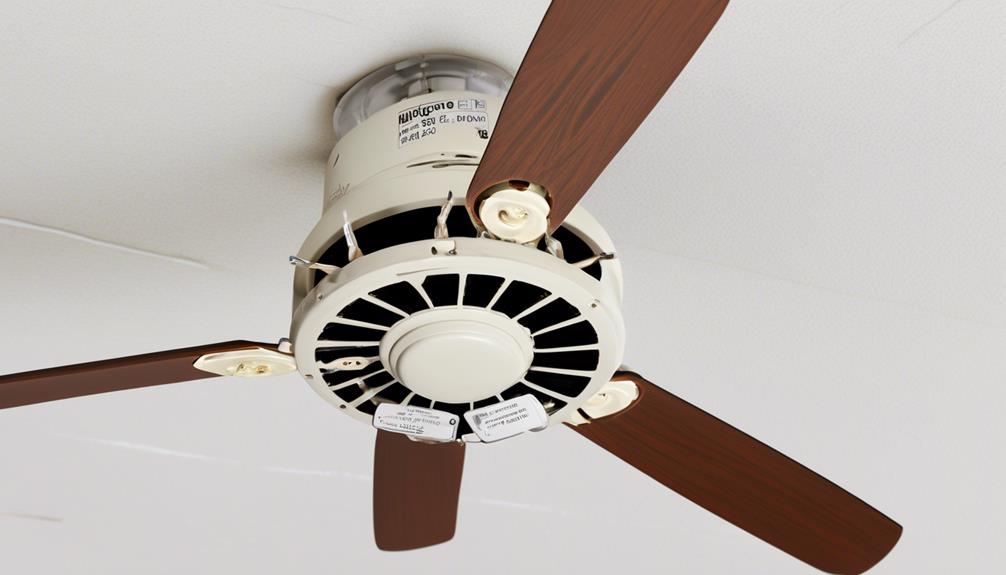
To diagnose and address ceiling fan speed issues, one potential culprit to consider is a faulty switch mechanism. The fan switch controls the speed of the fan blades, allowing you to adjust the airflow to your liking. If the switch is malfunctioning, it can cause the fan to operate at a slower speed or not work at all.
Troubleshooting the fan switch requires some basic knowledge and tools. First, ensure that the fan is turned off and disconnected from the power source. Carefully remove the fan switch cover and examine the wiring connections. Check for any loose or damaged wires and tighten or replace them as necessary.
If the wiring appears to be in good condition, the next step is to test the switch itself. Using a multimeter, set it to the resistance or continuity mode. With the switch in the off position, probe the terminals to see if there's any resistance or continuity. If there's no reading, the switch is likely faulty and needs to be replaced.
Fan switch replacement is relatively straightforward. Disconnect the old switch and remove it from the housing. Take note of the wire connections and transfer them to the new switch. Install the new switch into the housing, making sure it's securely in place. Replace the switch cover and reconnect the power source.
Frequently Asked Questions
How Can I Tell if My Ceiling Fan Has a Faulty Fan Motor?
When troubleshooting a ceiling fan, it's important to determine if the fan motor is faulty. To do this, we can look for certain signs.
Firstly, check for any unusual noises coming from the motor, as this can indicate a problem.
Additionally, observe if the fan is spinning at a slower speed than usual.
If both these symptoms are present, it's likely that the fan motor is faulty and may need to be replaced.
What Can I Do to Prevent Dust From Accumulating on My Fan Blades?
When it comes to ceiling fan cleaning tips, one of the best methods to remove dust from fan blades is to use a damp cloth or a vacuum cleaner with a brush attachment.
Regularly cleaning the blades can prevent dust from accumulating and affecting the fan's performance.
What Are the Signs of Improper Installation of a Ceiling Fan?
When discussing signs of improper installation of a ceiling fan, there are a few key indicators to look out for.
One common issue is ceiling fan wobbling, which can occur if the fan isn't securely mounted or if the blades are unbalanced.
Another sign is noise coming from the ceiling fan, which can be caused by loose screws or a faulty motor.
Proper installation is crucial for optimal performance and safety of the ceiling fan.
Can a Dirty or Clogged Air Vent Affect the Speed of My Ceiling Fan?
Can a dirty or clogged air vent affect the speed of our ceiling fan?
Absolutely. When the air vent becomes obstructed with dust or debris, it restricts the airflow, causing the fan to work harder to circulate air. This increased workload can lead to a decrease in speed and overall performance.
Regular maintenance, such as cleaning the air vent, is crucial to ensure optimal functioning of the ceiling fan. A clean and unobstructed air vent allows for efficient air circulation and maximum fan speed.
How Do I Adjust the Pitch of My Ceiling Fan Blades?
When it comes to ceiling fan maintenance, one important aspect to consider is troubleshooting the speed. Adjusting the pitch of the fan blades can help improve the fan's performance. By changing the angle at which the blades are set, you can optimize the airflow and increase the speed of the fan.
This can be done by loosening the blade screws and carefully adjusting the pitch until the desired speed is achieved. Regularly checking and adjusting the blade pitch is crucial for maintaining an efficient ceiling fan.
What Could Cause a Ceiling Fan to Suddenly Slow Down?
There are a few common reasons for slow ceiling fan. The most likely cause is a buildup of dust and debris on the fan blades, which can weigh them down and reduce their speed. Another potential culprit is a faulty capacitor, which may need to be replaced to restore the fan’s normal speed.
Conclusion
In conclusion, a slow ceiling fan can be caused by a variety of factors. These include incorrect fan settings, a faulty fan motor, dust accumulation on fan blades, improper installation, low fan speed setting, remote control malfunction, fan capacitor failure, incorrect fan direction, or a faulty fan switch.
It's important to address these issues promptly to ensure optimal fan performance and comfort in your space.
- About the Author
- Latest Posts
Introducing Ron, the home decor aficionado at ByRetreat, whose passion for creating beautiful and inviting spaces is at the heart of his work. With his deep knowledge of home decor and his innate sense of style, Ron brings a wealth of expertise and a keen eye for detail to the ByRetreat team.
Ron’s love for home decor goes beyond aesthetics; he understands that our surroundings play a significant role in our overall well-being and productivity. With this in mind, Ron is dedicated to transforming remote workspaces into havens of comfort, functionality, and beauty.
Appliances
3 Essential Tips for RV-Friendly Portable Washers

- Pros and cons of using eco friendly laundry detergent in a portable washer.
- Tips for preventing detergent residue buildup in a portable washer
Are you exhausted from constantly looking for laundromats during your RV trips? We get it. That’s why we’re here to provide three key tips for RV-friendly portable washing machines.
While you might be thinking, ‘Do I really need a portable washer?’ trust us, having one on your RV can be a game-changer. In this guide, we’ll show you how to choose the right size washer that fits your RV’s limited space, understand the power and water requirements to ensure smooth operation, and provide you with maintenance and cleaning tips to keep your washer running efficiently.
So, let’s dive in and master the art of laundry on the road!
Key Takeaways
- Consider the laundry capacity needed for your RV.
- Look for compact and lightweight options with space-saving features.
- Choose a portable washer with high energy efficiency and water conservation features.
- Regularly maintain and clean your portable washer using recommended cleaning products.
Choosing the Right Size
One of the first considerations when selecting a portable washer for our RV is determining the appropriate size. Portable washer features and space-saving options play a crucial role in making this decision. When it comes to size, it’s important to find a washer that fits well within the limited space of an RV, while still providing enough capacity to meet our laundry needs.
To begin with, portable washers come in a range of sizes, typically measured in pounds of laundry capacity. It’s essential to consider the amount of laundry we anticipate doing on a regular basis. While a smaller capacity may be suitable for individuals or couples, larger families might require a washer with a higher capacity to accommodate their laundry demands.
Additionally, it’s important to consider the physical dimensions of the washer. RVs have limited space, so opting for a compact and lightweight washer can help maximize the available room. Some portable washers are designed with space-saving features such as folding handles, detachable components, or even stackable options that can fit neatly into tight spaces.
Understanding Power and Water Requirements
When considering the power and water requirements for our RV-friendly portable washer, we need to understand the necessary resources for optimal performance.
Energy efficiency is an important factor to consider when choosing a portable washer for your RV. Look for models that have a high Energy Star rating, as this indicates that they consume less energy and can help you save on your electricity bills.

Additionally, portable washer features such as load sensing technology and adjustable water levels can help you conserve water. These features ensure that the washer only uses the amount of water necessary to clean your laundry, which is particularly crucial when you have limited water supply in your RV.
It’s also important to check the power requirements of the portable washer. Make sure that the washer is compatible with the power source available in your RV, whether it’s a standard 120-volt outlet or a 12-volt DC power source.
Understanding the power and water requirements of your RV-friendly portable washer won’t only help you achieve optimal performance but also contribute to energy and water conservation.
Maintenance and Cleaning Tips
Let’s talk about how to properly maintain and clean your RV-friendly portable washer. Taking care of your portable washer is essential to ensure its longevity and optimal performance. Regular maintenance and cleaning will help prevent any potential issues and keep your machine running smoothly. Here are some common troubleshooting tips and recommended cleaning products to keep in mind:
| Common Troubleshooting | Recommended Cleaning Products |
|---|---|
| Leaking water | Vinegar and water mixture |
| Excessive noise | Mild detergent |
| Drum not spinning | Baking soda |
| Error codes | Citric acid |
If you encounter a problem such as leaking water, try using a mixture of vinegar and water to clean the machine’s seals and hoses. For excessive noise, use a mild detergent to clean the drum and remove any debris that may be causing the noise. If the drum is not spinning, try using baking soda to remove any buildup that may be hindering its movement. Lastly, if you receive error codes, using citric acid in the detergent compartment can help clean the sensors and resolve the issue.
Remember to always refer to your portable washer’s manual for specific maintenance instructions and troubleshooting tips. By following these guidelines and using the recommended cleaning products, you can keep your RV-friendly portable washer in great condition and enjoy clean laundry on your travels.
Frequently Asked Questions
How Long Does It Typically Take to Wash a Full Load of Laundry Using a Portable Washer?
Typically, it takes around 30 to 45 minutes to wash a full load of laundry using a portable washer.
However, it’s important to consider the capacity limitations of these machines. Most portable washers have a smaller capacity compared to traditional washers, so it may take longer if you have a larger load.
It’s always a good idea to follow the manufacturer’s instructions and not overload the machine to ensure efficient and effective washing.
Can I Use Regular Laundry Detergent in a Portable Washer, or Do I Need to Use a Specific Type?
Yes, you can use regular laundry detergent in a portable washer. However, there are some pros and cons to consider.
Using eco-friendly laundry detergent in a portable washer is a great option for those who want to reduce their environmental footprint. It can be gentler on your clothes and safer for the environment.
However, some eco-friendly detergents may not be as effective at removing tough stains. To prevent detergent residue buildup, make sure to use the recommended amount of detergent and run an extra rinse cycle if needed.
Is It Safe to Leave a Portable Washer Unattended While It’s Running?
Safety precautions should be taken when using a portable washer unattended. There are potential risks involved, such as water leakage or electrical malfunctions. It’s important to follow the manufacturer’s instructions and guidelines for safe operation.
Some tips to minimize risks include ensuring a stable surface, avoiding overloading the machine, and regularly checking for any signs of damage.
It’s always best to err on the side of caution when it comes to leaving a portable washer running without supervision.
Can I Wash Delicate Fabrics, Such as Silk or Lace, in a Portable Washer?
When it comes to washing delicate fabrics like silk or lace in a portable washer, there are a few things to keep in mind.
Firstly, check the manufacturer’s instructions to ensure that your specific model is suitable for these types of fabrics.
Secondly, use a gentle cycle and cold water to minimize any potential damage.
Lastly, consider placing delicate items in a mesh laundry bag for added protection.
With these precautions, you can safely wash your delicate fabrics in an RV-friendly portable washer.

How Noisy Are Portable Washers When in Operation?
When it comes to the noise level of portable washers, it’s important to consider their energy efficiency as well. These machines are designed to be compact and efficient, so they tend to operate quietly. While they do make some noise during operation, it’s typically minimal and shouldn’t disturb your RV neighbors or disrupt your peaceful campsite.
Plus, their energy efficiency means you can enjoy clean clothes without draining your RV’s power supply.
Conclusion
In conclusion, choosing the right size portable washer for your RV, understanding power and water requirements, and following maintenance and cleaning tips are essential for a smooth laundry experience on the road.
By coincidence, we stumbled upon a fellow traveler at a campsite who’d just purchased a portable washer based on our article. They were thrilled with the convenience and efficiency it provided.
So, take these tips into consideration and enjoy clean clothes wherever your adventures take you!
- About the Author
- Latest Posts
Introducing Charles, the Editor in Chief at ByRetreat, whose passion for interior design and editorial excellence elevates every remote workspace to new heights. With his keen eye for detail, impeccable taste, and expertise in design, Charles brings a wealth of knowledge and creativity to the ByRetreat team.
As the Editor in Chief of a renowned lifestyle blog, Charles has honed his skills in curating captivating content and staying up-to-date with the latest trends in interior design. His deep understanding of aesthetics and the power of storytelling through design enables him to create remote workspaces that are not only visually stunning but also rich in personality and meaning.
Appliances
4 Smart Tips for Extended Commercial Appliance Warranties

Did you realize that nearly 80% of commercial appliance malfunctions happen after the manufacturer’s warranty runs out? As business operators, we grasp the significance of safeguarding our assets and reducing unforeseen costs.
That’s why we have compiled four smart tips for extended commercial appliance warranties that will help you make informed decisions and ensure the longevity of your appliances.
In this guide, we will discuss choosing the right warranty provider, understanding coverage and exclusions, evaluating the cost and value, and maximizing the benefits of extended warranties.
By following these tips, you can have peace of mind knowing that your appliances are protected and your business operations can continue smoothly.
Let’s dive in and master the art of extended warranties!
Key Takeaways
- Choose a warranty provider with a good reputation and track record.
- Understand the coverage details and limitations of the warranty.
- Evaluate the cost and value of extended warranties.
- Maximize the benefits by understanding the claim process and maintaining your appliances.
Choosing the Right Warranty Provider
When selecting a warranty provider for extended commercial appliance warranties, we should consider their reputation and track record in the industry. Identifying reputable providers is crucial to ensure that we’re dealing with a company that has a history of delivering on their promises and providing excellent service to their customers. A reputable provider will have a strong presence in the market and positive reviews from satisfied clients. They’ll also have a proven track record of handling warranty claims efficiently and resolving issues promptly.
In addition to reputation, it’s important to compare warranty terms offered by different providers. We should carefully review the terms and conditions of each warranty to ensure that they meet our specific needs and requirements. This includes understanding the coverage provided, such as if it includes parts and labor costs, and the duration of the warranty. It’s also important to consider any limitations or exclusions that may apply.
Understanding Coverage and Exclusions
To fully understand the extent of coverage and any exclusions, we should carefully review the warranty terms and conditions for our extended commercial appliance warranties. Many people have common misconceptions about what’s covered under these warranties, which is why it’s so important to read the fine print. Here are some key points to consider:
- Scope of coverage: It’s crucial to understand what types of repairs or replacements are included in the warranty. This may vary depending on the provider and the specific appliance being covered. Some warranties may only cover certain parts or components, while others may offer more comprehensive coverage.
- Exclusions: Even though warranties provide coverage, there are often exclusions stated in the terms and conditions. These exclusions may include damage caused by misuse, neglect, or unauthorized repairs. It’s important to be aware of these exclusions to avoid any surprises when filing a claim.
- Duration of coverage: Extended commercial appliance warranties can vary in terms of their duration. Some warranties may provide coverage for a fixed period of time, while others may offer coverage until a certain number of repairs or replacements have been made. Understanding the duration of coverage can help us plan for future maintenance and repairs.
- Claim process: Familiarizing ourselves with the claim process is essential. This includes knowing who to contact, what documentation is required, and any specific procedures that need to be followed to ensure a smooth and efficient claim experience.
Evaluating the Cost and Value
To determine the cost-effectiveness of extended commercial appliance warranties, we need to assess their overall value. When weighing options and considering budget considerations, it is essential to evaluate the benefits and drawbacks of purchasing extended warranties for your appliances. To help you make an informed decision, we have created a table that outlines the key factors to consider:
| Factors to Consider | Benefits | Drawbacks |
|---|---|---|
| Coverage | Extended protection beyond the manufacturer’s warranty period | Additional cost |
| Repair Costs | Potential savings on repair expenses | Warranty cost may outweigh repair costs |
| Peace of Mind | Assurance that your appliances are protected | Limited likelihood of appliance failure |
By considering these factors, you can determine whether the cost of an extended warranty is justified by its value. It is important to note that budget considerations should not be the sole determining factor. While extended warranties may come at an additional cost, they can provide peace of mind and potential savings on repair expenses.
In the next section, we will explore strategies for maximizing the benefits of extended warranties, ensuring that you get the most value out of your investment.
Maximizing the Benefits of Extended Warranties
To maximize the benefits of extended warranties, we can employ strategies that optimize our investment. By understanding the claim process and exploring renewal options, we can ensure that our commercial appliance warranties provide us with the maximum value and protection.
Here are some smart tips for maximizing the benefits of extended warranties:
- Thoroughly understand the claim process: Familiarize yourself with the steps involved in filing a claim. Know the required documentation, such as proof of purchase and warranty information. By being prepared, you can expedite the claim process and minimize downtime.
- Regularly maintain your appliances: Proper maintenance is crucial for the longevity and performance of your commercial appliances. Follow the manufacturer’s guidelines for cleaning, servicing, and inspections. Regular maintenance not only extends the lifespan of your appliances but also helps prevent potential issues that may require warranty claims.
- Research renewal options: When your extended warranty is about to expire, explore renewal options offered by the warranty provider. Some providers offer extended renewal plans with additional coverage, giving you continued peace of mind and protection for your investment.
- Keep warranty documents organized: Maintain a dedicated folder or digital file for all your warranty documents. This ensures easy access to necessary information when filing a claim or renewing your warranty.
Frequently Asked Questions
How Can I Extend the Warranty on My Commercial Appliance if It’s Already Expired?
To extend the warranty on your commercial appliance after it has expired, there are several renewal options available.
You can contact the manufacturer or a third-party warranty provider to inquire about their extended warranty programs. They may offer coverage plans specifically designed for appliances with expired warranty coverage.
It’s important to carefully review the terms and conditions, as well as the cost, of these extended warranty options to ensure they meet your needs and budget.
Are There Any Specific Requirements or Limitations for Obtaining an Extended Warranty for Commercial Appliances?
When obtaining an extended warranty for commercial appliances, it’s important to be aware of the common exclusions in extended warranty coverage. These may include wear and tear, cosmetic damage, and misuse or negligence.
To choose the right extended warranty, consider factors such as the length of coverage, cost, and reputation of the provider.
It’s also crucial to thoroughly read and understand the terms and conditions of the warranty to avoid any surprises down the line.
Can I Transfer My Extended Warranty to a New Owner if I Sell My Commercial Appliance?
Yes, you can transfer your extended warranty to a new owner if you sell your commercial appliance. This ensures that the warranty coverage for used appliances continues with the new owner.
It’s important to check the specific requirements and limitations of your extended warranty to ensure a smooth transfer process. By transferring the warranty, you provide peace of mind to the new owner and protect them against any unexpected repair or replacement costs.
What Happens if My Commercial Appliance Breaks Down Multiple Times During the Extended Warranty Period?
If your commercial appliance breaks down multiple times during the extended warranty period, you may be eligible for claim reimbursement. The repair or replacement timeline will depend on the terms and conditions of your warranty.
It’s important to thoroughly review the warranty agreement to understand the process and any limitations. Our team is here to help ensure that your claims are handled efficiently and that you receive the necessary repairs or replacements in a timely manner.
Is There a Limit to the Number of Claims I Can Make Under an Extended Warranty for My Commercial Appliance?
There are limitations to the number of claims we can make under an extended warranty for our commercial appliance.
However, it’s important to note that extended warranties offer numerous benefits for commercial appliances. They provide peace of mind by covering repairs and replacements, reducing downtime and maintenance costs.
Conclusion
In conclusion, when it comes to extended commercial appliance warranties, there are several crucial considerations to keep in mind.
Firstly, choosing the right provider is essential. It’s important to research and compare different warranty providers to ensure they have a good reputation and offer comprehensive coverage.
Understanding coverage and exclusions is also crucial. Businesses should carefully review the terms and conditions of the warranty to know exactly what is covered and what is not. This will help avoid any surprises or disappointments down the line.

Evaluating cost and value is another important factor. Businesses should consider the cost of the warranty in relation to the potential repair or replacement costs of the appliances. They should also assess the value of the warranty by considering additional benefits such as extended service hours or priority service.
Lastly, maximizing benefits is key. Businesses should take advantage of all the benefits offered by the warranty, such as regular maintenance or discounted repairs. This will help ensure the appliances are well-maintained and any issues are addressed promptly.
By following these smart tips, businesses can make informed decisions that protect their investments. Just like a well-oiled machine, a well-chosen warranty can provide peace of mind and keep the business running smoothly. So don’t leave your appliances vulnerable, take action and secure their longevity today.
- About the Author
- Latest Posts
Introducing Charles, the Editor in Chief at ByRetreat, whose passion for interior design and editorial excellence elevates every remote workspace to new heights. With his keen eye for detail, impeccable taste, and expertise in design, Charles brings a wealth of knowledge and creativity to the ByRetreat team.
As the Editor in Chief of a renowned lifestyle blog, Charles has honed his skills in curating captivating content and staying up-to-date with the latest trends in interior design. His deep understanding of aesthetics and the power of storytelling through design enables him to create remote workspaces that are not only visually stunning but also rich in personality and meaning.
Appliances
3 Essential DIY HVAC Maintenance Tips Unveiled

Ah, the pleasures of tending to our HVAC systems! We understand the excitement of dedicating our valuable time to the upkeep and repair of these marvelous devices. But do not worry, dear reader, as we have revealed the tips to becoming skilled at DIY HVAC maintenance.
In this guide, we will unveil three essential tips that will ensure your HVAC system remains in perfect harmony. Get ready to dive into the world of air filters, thermostat settings, and outdoor condenser units. We will show you how to clean, check, and clear with ease, all while achieving that coveted mastery over your HVAC system.
So, let’s roll up our sleeves and get down to business, shall we?
Key Takeaways
- Regular maintenance, including cleaning air filters and checking thermostat settings, is essential for optimal HVAC system performance.
- Cleaning or replacing air filters prevents clogging and maintains a healthy indoor environment.
- Checking and maintaining thermostat settings ensures accurate temperature control and programming.
- Clearing debris from the outdoor condenser unit improves its performance and prevents airflow restriction.
Cleaning Air Filters Regularly
We recommend cleaning air filters regularly to ensure proper airflow and maintain optimal HVAC system performance. Replacing air filters is a crucial part of HVAC maintenance that often gets overlooked.
Air filters play a significant role in improving indoor air quality by capturing dust, pollen, and other airborne particles. Over time, these particles can accumulate on the filters, causing them to become clogged and obstructing the airflow. This can result in reduced efficiency and increased energy consumption.
By cleaning or replacing air filters on a regular basis, you can prevent these issues and maintain a healthy indoor environment.
Cleaning air filters is a relatively simple task that can be done by the homeowner. Start by turning off the HVAC system and locating the air filter. Remove the filter and inspect it for any visible dirt or debris. If the filter is washable, gently clean it with water and a mild detergent. Allow it to dry thoroughly before reinstalling. If the filter isn’t washable, it should be replaced with a new one. Remember to check the manufacturer’s recommendations for the appropriate filter type and replacement schedule.
Checking and Maintaining Thermostat Settings
To ensure optimal HVAC system performance, it’s important to regularly check and maintain the thermostat settings. The thermostat acts as the control center for your heating and cooling system, allowing you to adjust the temperature and program a schedule that suits your needs.
Start by adjusting the temperature settings to the desired level. This can be done manually or through programming. If you prefer a consistent temperature throughout the day, programming a schedule can help save energy and maintain comfort. Make sure to set different temperatures for when you’re away from home or asleep.
Regularly check the accuracy of your thermostat by comparing it to a separate thermometer. If there’s a discrepancy, recalibrate the thermostat to ensure accurate readings.
Keep the thermostat clean and free from dust and debris. Use a soft cloth to wipe away any buildup that may affect its functionality.
Lastly, check the batteries in your thermostat. Dead or low batteries can cause the thermostat to malfunction. Replace them as needed to ensure proper operation.
Clearing Debris From Outdoor Condenser Unit
Clearing debris from the outdoor condenser unit involves removing any dirt, leaves, and other obstructions that can hinder its performance. It’s important to regularly inspect and clean the condenser coil to ensure optimal functioning of the HVAC system.
To begin, it’s crucial to remove any vegetation that may have grown around the outdoor condenser unit. Plants, shrubs, or trees that are too close to the unit can restrict airflow and reduce its efficiency. Cut back any overhanging branches or foliage that may block the airflow and impede the unit’s ability to cool the air effectively.
Next, inspect the condenser coil for any debris buildup. Over time, dirt, leaves, and other particles can accumulate on the coil, obstructing the airflow and reducing its heat transfer capabilities. Gently brush away any debris using a soft-bristle brush or a vacuum cleaner with a brush attachment. Be careful not to damage the delicate fins of the coil during the cleaning process.
In addition to removing debris, it’s essential to inspect the coil for any signs of damage or corrosion. If any bent fins are detected, use a fin comb to straighten them out carefully. If there’s significant damage or corrosion, it’s recommended to contact a professional HVAC technician for further assessment and repair.
Regularly clearing debris and maintaining the condenser coil will help ensure that the outdoor unit operates efficiently and prolong its lifespan. By following these simple steps, you can optimize the performance of your HVAC system and maintain a comfortable indoor environment.
Frequently Asked Questions
How Often Should I Clean or Replace My Air Filters?
To improve the air quality in our homes, it’s essential to clean or replace air filters regularly. So, how often should we clean or replace them?
It’s recommended to clean or replace air filters every 1 to 3 months, depending on factors like the type of filter, the level of pollutants, and the frequency of HVAC system usage. Regular maintenance ensures that the air flowing through our HVAC system is clean and healthy, promoting a comfortable and safe living environment.
Can I Use Any Type of Air Filter for My HVAC System?
Can we use any type of air filter for our HVAC system?

It’s important to understand that not all air filters are created equal. There are different types of air filters available in the market, each with its own specifications and benefits.
Using the right filter for your HVAC system is crucial in ensuring optimal performance and indoor air quality. It’s recommended to consult with a professional to determine the best filter for your specific system and needs.
Are There Any Specific Thermostat Settings I Should Be Aware of During Different Seasons?
During different seasons, it’s important to adjust thermostat programming to maximize energy efficiency. By setting higher temperatures in the summer and lower temperatures in the winter, you can reduce the workload on your HVAC system and save on energy costs.
Additionally, utilizing programmable thermostats can help automate these adjustments, ensuring optimal comfort and efficiency.
How Can I Determine if the Outdoor Condenser Unit Is Blocked by Debris?
To determine if the outdoor condenser unit is blocked by debris, we can look for certain signs.
One key indicator is reduced airflow coming from the unit. If you notice that the air isn’t flowing as strongly as before, it could be a sign of blockage.
Another sign to watch out for is unusual noises coming from the condenser, which could indicate damage.
Regularly inspecting and cleaning the unit will help prevent any potential issues and ensure optimal performance.
What Are the Potential Consequences of Not Regularly Cleaning the Air Filters or Clearing Debris From the Outdoor Condenser Unit?
Neglecting HVAC maintenance can lead to serious consequences. Regularly cleaning air filters and clearing debris from the outdoor condenser unit is of utmost importance. Failure to do so can result in reduced airflow, decreased efficiency, and higher energy bills.
Additionally, dirty filters can lead to poor indoor air quality and potential health issues. By prioritizing regular HVAC maintenance, we ensure optimal performance, extend the lifespan of our system, and create a healthier and more comfortable living environment.
Conclusion
In conclusion, by regularly cleaning air filters, checking and maintaining thermostat settings, and clearing debris from the outdoor condenser unit, homeowners can ensure optimal performance and efficiency of their HVAC systems.
These essential DIY maintenance tips not only extend the lifespan of the system but also improve indoor air quality and reduce energy consumption.
By taking these simple steps, homeowners can enjoy a comfortable and healthy living environment while saving on utility bills.
- About the Author
- Latest Posts
Introducing Charles, the Editor in Chief at ByRetreat, whose passion for interior design and editorial excellence elevates every remote workspace to new heights. With his keen eye for detail, impeccable taste, and expertise in design, Charles brings a wealth of knowledge and creativity to the ByRetreat team.
As the Editor in Chief of a renowned lifestyle blog, Charles has honed his skills in curating captivating content and staying up-to-date with the latest trends in interior design. His deep understanding of aesthetics and the power of storytelling through design enables him to create remote workspaces that are not only visually stunning but also rich in personality and meaning.
-

 Vetted2 days ago
Vetted2 days ago15 Best Folding Beds for Small Spaces – Space-Saving Solutions for Comfort and Convenience
-

 Vetted18 hours ago
Vetted18 hours ago15 Best Waterproof Flooring Options for Your Bathroom – Ultimate Guide & Reviews
-

 Vetted6 days ago
Vetted6 days ago15 Best Grocery Carts to Make Shopping a Breeze
-

 Vetted2 weeks ago
Vetted2 weeks ago15 Best Gravel for Driveway: The Ultimate Guide for a Durable and Stunning Entrance
-

 Vetted4 days ago
Vetted4 days ago15 Best Steam Generators for Showering Bliss: Reviewed & Rated
-

 Beginners Guides3 weeks ago
Beginners Guides3 weeks agoI Inhaled Vinegar Fumes
-

 Vetted2 weeks ago
Vetted2 weeks ago15 Best Hot Tubs of 2024: Luxurious Relaxation at Your Fingertips
-

 Vetted4 weeks ago
Vetted4 weeks ago15 Best Blinds for Bathroom Windows to Enhance Privacy and Style


























